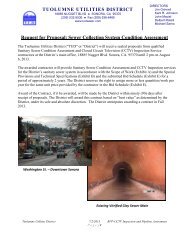Historic Resource Evaluation Project - Tuolumne Utilities District
Historic Resource Evaluation Project - Tuolumne Utilities District
Historic Resource Evaluation Project - Tuolumne Utilities District
Create successful ePaper yourself
Turn your PDF publications into a flip-book with our unique Google optimized e-Paper software.
Placer gold was discovered in the limestone belt around Columbia as early as 1849, but<br />
water was needed to work the placers during the dry seasons. In order to work their<br />
claims, the miners in Columbia formed a company to bring water to the area, and on July<br />
1 st of 1851 the TCWC began digging a ditch from the South Fork Stanislaus River to the<br />
district to supply the mines and communities in the area. System water first reached<br />
Columbia through Five Mile Creek in May of 1852, and by August the entire ditch and<br />
flume system was completed and has been in continuous use since.<br />
In addition to Columbia, the ditch supplied Shaw’s Flat, where placering had begun as<br />
early as 1848; Springfield, at the head of Mormon Creek; Matelot Gulch, named for the<br />
French sailors who mined there in the 1850s; Martinez, for Doña Martinez, where gold<br />
was discovered in the 1850s; Knapp’s Ranch on San Diego Hill; Knickerbocker Flat;<br />
Sawmill Flat at the forks of Wood’s Creek, where Mexicans, Chilenos, and Peruvians<br />
mined; Yankee Hill at the head of Wood’s Creek; Squabbletown; Douglasville; Gold<br />
Springs; Union Hill; and numerous other camps whose names have been lost to history.<br />
Depicted on the map drafted by John Wallace in 1853, a veritable spider web of ditches<br />
and flumes radiated around Columbia, bringing water to each and every mine, claim, and<br />
gulch throughout the district (Figure 10). Numerous other unmapped ditches carried<br />
water through privately owned ditches from the company system to individual claims and<br />
reservoirs. TCWC reservoirs depicted at that time included Matelot, San Diego, Gold<br />
Hill, Byrd’s, Copeland’s, Deadman’s, Summit Pass, and others (Wallace 1853, 1861,<br />
1863).<br />
By the time Wallace completed his next map of the district nine years later, over 12<br />
reservoirs were depicted surrounding Columbia, and in the ensuing years he designed the<br />
Saw Mill Flat Flume; a pipeline across Yankee Hill Road; a reservoir in Hardscrabble<br />
Gulch; flumes across Experimental Gulch and Summit Pass; a flume from the End of<br />
Pipe to the Head of Negro Gulch; the Union Flume; and probably many others for which<br />
no plans are extant (Figures 12, 19, 20, 21, 22, 23; Wallace 1862; Wallace Plans n.d.,<br />
various).<br />
The 1870 GLO Plats for T2N, R14E and 15E, depict the Columbia Ditch in<br />
approximately the same location as the present alignment, as do the Dart (1879),<br />
Beauvais (1882), and Barton (1896) maps. The 1907 Thom Map and 1909 <strong>Tuolumne</strong><br />
Water Power Company Map reflect the same alignment, and depict Matelot, San Diego,<br />
Gold Hill, Copeland, Byrd, Deadman, and Race Track reservoirs.<br />
Ditches no longer in operation that were connected to the Columbia Ditch at the top of<br />
Big Hill include the Bald Mountain Branch (1.42 miles long), which connected to<br />
Sawmill Flat and vicinity and to the reservoirs of the Electric Light and Old Miner’s<br />
Reservoirs, providing water to a power generating station in Sonora (Deed Book 46:417,<br />
520; Grunsky 1896; Rhodin 1916). Other branch ditches carried water to the Old Smooth<br />
Bore and Hardscrabble mines (Barton 1896; Dart 1879), and as far south as the Radovich<br />
and Belmont mines in Section 24, T2N, R14E, near Brown’s Flat (Figures 24, 25; Barton<br />
1896). The Dondero Ditch carried water from about one mile below Big Hill Camp and<br />
Foothill <strong>Resource</strong>s, Ltd. 4.12 TUD Ditch Sustainability <strong>Project</strong><br />
Francis Heritage, LLC<br />
<strong>Historic</strong> <strong>Resource</strong> <strong>Evaluation</strong> Report




